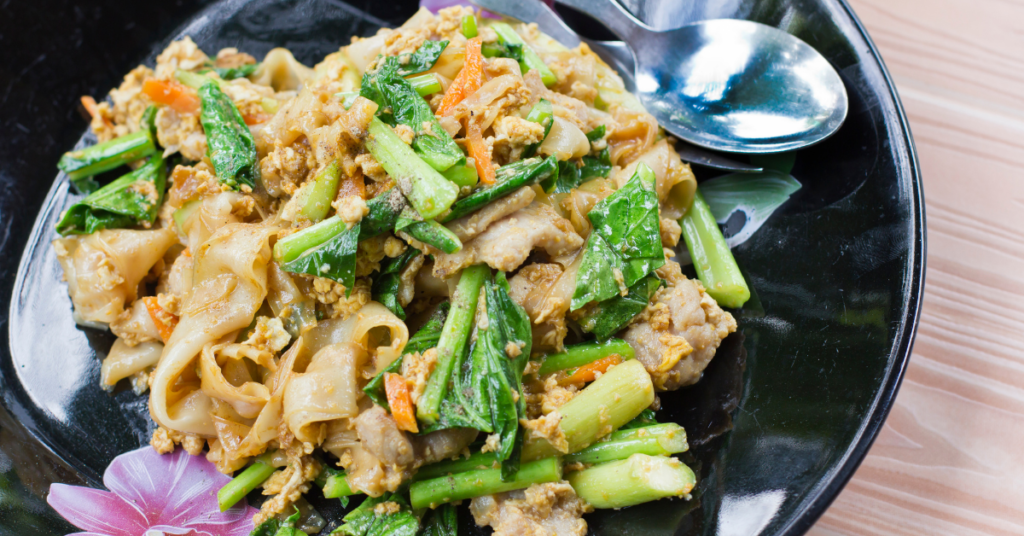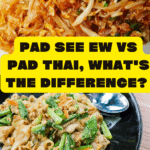Pad See Ew vs Pad Thai, what’s the difference? Whether you are ordering from a Thai restaurant and need to know the difference quickly or want to make these dishes at home, we can help!
Pad See Ew vs Pad Thai: they’re both delicious, easy to find at most restaurants and have a unique + complex flavor profile that sets them apart. However, if you’re new to Thai cuisine, you may wonder what the difference is between Pad See Ew and Pad Thai.
For many of us, there’s nothing more comforting than a bowl of hot noodles straight from the wok. It doesn’t matter whether you are using an electric wok burner or gas stove, making pad thai or pad see ew is easy!
Pad See Ew and Pad Thai are stir-fried noodle dishes typically made with vegetables, noodles, and sometimes meat. And the best part is that you can easily make each meal vegan or vegetarian.
Pad See Ew is made with wide, flat rice noodles, while Pad Thai is made with thin, flat rice noodles. Additionally, each dish’s sauces and thai spices differ, giving them unique flavor profiles.
Ingredients – Pad See Ew vs Pad Thai
The ingredients in each dish are what sets them apart when it comes to Pad See Ew vs Pad Thai. Here’s what you can expect to find in each:

Pad See Ew
You typically make Pad See Ew with the following ingredients:
- Wide rice noodles
- Dark soy sauce like tamari or thai soy
- Oyster sauce
- Chinese broccoli, kale, or any other vegetable you want to throw in
- A protein of your choice (chicken, mock duck, beef, pork, shrimp, or tofu)
- Garlic
- Eggs
The noodles used in Pad See Ew are broader than those used in Pad Thai, giving the dish a heartier texture. The sauce combines dark soy sauce and oyster sauce (or fish sauce), creating a savory and slightly sweet flavor.
Plus, Chinese broccoli or kale will add a touch of bitterness to the dish, while garlic and eggs add depth and richness. Feel free to use one of our tamari substitutes.
Pad Thai
Pad Thai typically includes the following ingredients:
- Thin rice noodles
- Tamarind paste
- Fish sauce
- Bean sprouts
- Scallions
- A protein of your choice (chicken, mock duck, beef, pork, shrimp, or tofu)
- Eggs
- Garlic
- Crushed peanuts
- Lime wedges
The noodles used in Pad Thai are thinner than those used in Pad See Ew, giving the dish a lighter texture. You make the sauce with tamarind paste and fish sauce, providing a tangy and slightly sweet flavor.
Next, you use bean sprouts and scallions to add crunch and freshness to the dish. Lastly, you always serve crushed peanuts and lime wedges on the side for added texture and flavor.
Taste and Texture – Pad See Ew vs Pad Thai
Pad See Ew

Pad See Ew is a popular fast food Thai dish that’s infamous for its sweet and savory flavor. This Thai staple has wide rice noodles, soy sauce, oyster sauce, garlic, and Chinese broccoli.
More importantly, the noodles are stir-fried until they are slightly charred, which gives them a smoky flavor. The dish has a chewy texture from the noodles and a slight crunch from the Chinese broccoli.
Pad See Ew has a unique flavor that is different from Pad Thai. The dish is less sweet than Pad Thai but has a strong umami flavor from the dark soy sauce and fish/oyster sauce. Plus, the smoky flavor from the charred noodles adds depth to the dish and makes it more satisfying.
Pad Thai

Pad Thai is a classic Thai dish made with thin rice noodles, eggs, tofu, shrimp, bean sprouts, and peanuts. More importantly, Pad Thai has a sweet and sour flavor, balanced by the savory umami flavor of fish sauce.
Furthermore, the noodles are stir-fried until they are slightly crispy, which gives them a satisfying crunch. For more Thai dish comparisons check out Pad Thai vs Drunken Noodles.
Pad Thai has a sweeter flavor profile than Pad See Ew. The dish is known for its balance of sweet, sour, and savory flavors. We love the addition of peanuts; it adds a crunchy texture, which makes it more enjoyable to eat.
History and Origin
Thai cuisine has become increasingly popular worldwide in recent years, and two of the most well-known dishes are Pad See Ew and Pad Thai.
Both dishes are stir-fried noodle dishes often served as street food in Thailand. They are meant for you to eat on the go!
Pad See Ew
Pad See Ew means “stir-fried soy sauce noodles” in Thai. The dish is made with wide, flat rice noodles, which are stir-fried with soy sauce, meat (usually chicken, mock duck, tofu, or beef), Chinese broccoli, and egg.
Some say that Pad See Ew originated in China then the technique got brought to central Thailand, where small mom-and-pop vendors sold it as street food during the early 20th century. Today, it is a staple in Thai restaurants around the world.
Pad Thai
Pad Thai is another popular Thai noodle dish made with thin rice noodles. You stir-fry the meal with eggs, tofu, bean sprouts, and other ingredients, including shrimp, chicken, or beef.
The origination of Pad Thai in the mid-20th century occurred during a period of nationalism in Thailand. The government was promoting the consumption of rice noodles as a way to reduce rice consumption, which was seen as a way to promote Thai identity and independence.
Nutrition – Pad Thai vs Pad See Ew
When choosing between Pad See Ew vs Pad Thai, you might wonder which is healthier. Let’s take a closer look at the nutrition facts for each dish.
Pad See Ew
The nutrition and calories in a serving of Pad See Ew will differ depending on how much oil, salt, and sugar you use.
While Pad See Ew is high in calories and fat, it also contains a large amount of protein. However, it is also high in sodium, which can concern some people.
Pad Thai
Since a serving of Pad Thai will differ on what ingredients you use, we cannot give a nutritional breakdown.
Remember that Pad Thai is typically higher in calories and fat than Pad See Ew and contains more sugar. Furthermore, it is also higher in sodium. So if you are watching your sodium intake, skip this dish at a Thai restaurant.
Overall, both dishes are high in calories and fat but also contain a good amount of protein. If you want to make a healthier choice, consider sharing the plate or choosing a smaller portion size. Additionally, you can ask for less oil or sauce to be used in the dish to reduce the calorie and fat content.
Conclusion
After comparing Pad See Ew and Pad Thai, you better understand the differences between the two dishes. While both are delicious and popular Thai dishes, their preparation, flavor profile, and ingredients differ.
If you prefer a sweeter and nuttier flavor, Pad Thai is the way to go. It is a more popular dish and is often the go-to choice for those new to Thai cuisine. On the other hand, if you enjoy a savory and smoky flavor with a chewy texture, Pad See Ew is the perfect dish for you. It is a heartier dish and is often served as a comfort food.
Ultimately, the decision between Pad See Ew and Pad Thai comes down to personal preference. Both dishes are delicious and offer a unique taste of Thai cuisine. Whether you want something savory or sweet, you can’t go wrong with either of these Thai classics .

